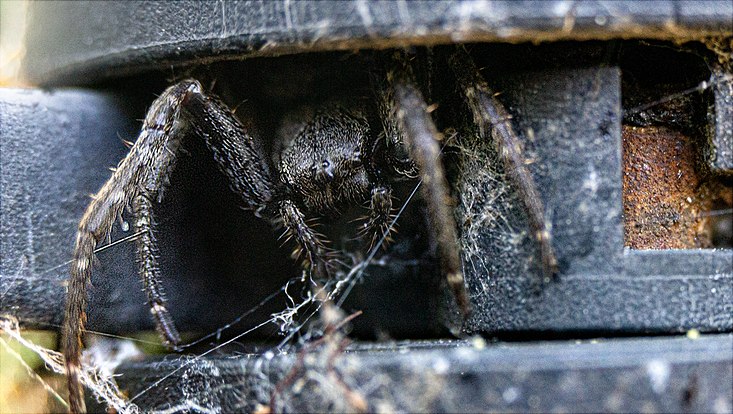
A scary beautiful treasure of the month
7 October 2019

Photo: UHH/CeNak, Herbold
Hard to spot: our students found this bridge spider in a bicycle gear shift.
Damp mist on sticky spider web threads, long hairy legs and a dark head. Well camouflaged, it peeks out of a rusty bicycle gear and can only be discovered at second glance. If you're looking for candy on Halloween, chances are you'll come across our Treasure of the Month for October. The bridge spider (Larinioides sclopetarius), which is widespread in Central Europe, only ventures out into its web at night. During the day, it stays in its safe hiding place.
Well hidden
In search of spiders in Hamburg's urban habitat, two students from LIB's arachnology department set out - and found what they were looking for: a bridge cross spider, at first glance hard to spot in a bicycle bell near the federal highway. They were unable to catch the nimble spider, however, and it quickly retreated into its hiding place. No problem for the two students, after all, there is already a specimen of the bridge cross spider in the LIB's arachnological collection.
Appearance
Bridge cross spiders have a flattened, brownish body, a black sternum, and a species-typical bright stripe pattern on the anterior abdomen. The V-shaped white pubescence and a white hairline on the head and sides are particularly conspicuous. Male spiders grow to about 6 - 8 millimeters in size and have a smaller abdomen with more contrasting markings, while female spiders grow to about 10 - 19 millimeters in size and have a much darker ground coloration.
Widespread and highly specialized
Bridge spiders are widespread throughout much of Europe and North America, but are particularly strong in urban areas. In terms of habitat, the spider species is highly specialized. Named for its preference for structures over water, the bridge cross spider feels most comfortable in close proximity to water and residential areas. Cities and water serve as a type of heat island, also called an urban heat island (UHI), created by anthropogenic influences in the city. It spins large cycling webs in harbors and parking garages, on rocks above open water and structures, or even on streetlights. Light helps it attract prey.
Colonies of solitary spiders
Bridge cross spiders rarely come alone - the population density at the sites is often very high. It is not uncommon for veritable carpets of individual wheel webs to form. Assemblages and entire colonies of their kind are often found. Nevertheless, bridge cross spiders are solitary animals, they do not share their prey. Occasionally, though not frequently, cannibalism occurs.
Further information
